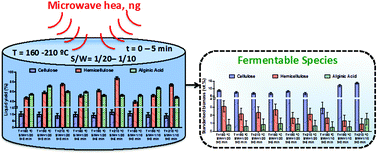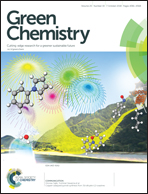Production of fermentable species by microwave-assisted hydrothermal treatment of biomass carbohydrates: reactivity and fermentability assessments†
Abstract
This work addresses and compares the production of fermentable species by microwave-assisted hydrothermal treatment of cellulose and hemicellulose (from lignocellulose) and alginic acid (from macroalgae). A reliable reactivity comparison was established at different temperatures (160–210 °C), reaction times (0 and 5 min) and solid/water mass ratios (1/20 and 1/10 g/g). The nature of the carbohydrates and the hydrothermal conditions had a significant influence on the reactivity, which increased as follows: cellulose < hemicellulose < alginic acid. The operating conditions did not influence the global conversion obtained during hydrothermal treatment of cellulose. Conversely, the temperature and reaction time played an important role when processing hemicellulose or alginic acid. In these two cases, increasing the temperature and/or reaction time increased the overall conversion and liquid and gas yields. The liquid hydrolysates were made up of a mixture of oligo-(DP 3–6 and DP > 6) and mono-/di-saccharides, carboxylic acids, ketones and furans. While the chemical composition of the hydrolysates produced from hemicellulose was not affected by the microwave operating conditions, the liquids having a high concentration of DP > 6 oligosaccharides in all cases, the microwave conditions substantially influenced the composition of the liquids produced from cellulose and alginic acid. The former contained high proportions of oligosacharides and saccharides and the latter comprised water soluble DP > 6 oligomers/oligosaccharides, saccharides, carboxylic acids and furans. The yeast Metschnikowia pulcherrima, previously demonstrated to be inhibitor tolerant and to metabolise a range of oligosacchaides, was used to assess the fermentability of the liquid fraction. All the hydrolysates produced were fermentable; their efficiency (standarised yeast biomass growth) decreasing as follows: cellulose (high/low saccharides/inhibitors proportion) > hemicellulose (high/low oligosaccharides/inhibitors proportion) > alginic acid (low/high saccharides/inhibitors proportion). Therefore, the promising results obtained in this work and the intrinsic green nature of the process make this method a very promising route for biomass valorisation, which can help to enable the development of new thermochemical and biological linked routes.



 Please wait while we load your content...
Please wait while we load your content...